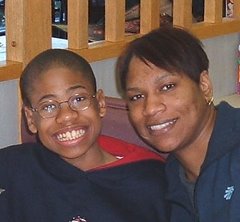By Dan Olmsted
UPI Senior Editor
Whatever the reason, a big decline in autism diagnoses would be welcome news to anyone who cares about the nightmarish prevalence of the disorder.
The latest signal that something may be going on comes from the father-and-son research team of Dr. Mark R. Geier and David A. Geier. They report in the spring issue of the Journal of American Physicians and Surgeons that "significant decreasing trends in newly diagnosed NDs (neurodevelopmental disorders) were observed ... from mid-2002 through 2005" in two separate databases.
The first is kept by the California Department of Developmental Services and is widely regarded as the most accurate barometer of full-syndrome, professionally diagnosed cases of autism. Those qualifiers are important because autism spectrum disorders run the gamut from severe (full-syndrome) to milder (Asperger's disorder) to hard to define (the awfully named PDD-NOS, or pervasive developmental disorders, not otherwise specified).
So focusing on the full-syndrome cases -- the most easily identified and indisputable -- is a smart way to go.
The other database is the Vaccine Adverse Events Reporting System maintained by the federal government, to which health professionals, parents and anyone else can report what they believe are side effects of vaccines.
That's much less consistent and credible, of course, but the Geiers see the VAERS information as an informal confirmation of the California data --companion graphs printed side by side in the study show remarkably similar rise-and-falls in autism.
"The consistency of the effects observed for the spectrum of NDs, including autism and speech disorders, and the agreement between the observations from two separate databases, support the conclusion that the effect is real and not a chance observation. The magnitude of the change in the trend lines is substantial," the Geiers write.
The Geiers also cite another confirmation: "(P)rovisional data from the U.S. Department of Education show a recent decrease of 529 in the number of new autism diagnoses recorded among children 3 to 5 years old, after years of annual increases. There were 1,451 new cases in 2001-2002; 1,981 in 2002-2003; 3,707 in 2003-2004; and 3,178 in 2004-2005."
The Geiers attribute the rise and fall to the increasing use of the mercury preservative thimerosal in childhood vaccines in the 1990s, followed by the phase-out beginning in 1999. While federal health authorities and mainstream medical groups say concern about thimerosal is not founded on good science, the Geiers think the trends ought to prompt a fresh look at the theory.
The people I talk to who think the preservative may indeed have triggered the rise in autism don't know what to make of all these numbers. While the autism rate may be falling as indicated in these databases, they say it's far too soon to make conclusive claims.
Some, in fact, have told me they think it should be falling further, faster if thimerosal is really behind the autism epidemic. Others suspect the connection is already there to see in exactly those numbers.
Then there's the possible confounding effect of flu shots for children and pregnant women, most of which still contain thimerosal. A number of other vaccines retain "trace" amounts of thimerosal.
And despite the welcome trends in data cited by the Geier, some countervailing reports are troubling. For example, reporter Steven Carter wrote in The Oregonian just last week that "(c)hildren diagnosed with autism, a brain disorder that disrupts a child's communication and social skills, jumped from 5,070 in 2004 to 5,637 in December. Over five years, the number of autistic students rose by 67 percent."
I'm sure someone can reconcile that with figures suggesting autism is on its way down, but I can't.
"We wish we knew exactly what is going on," said an admirably tentative Dr. Bob Nickel, a developmental pediatrician who heads the Autism Training Network at Oregon Health & Science University. He told Carter environmental issues could be at work.
Certainly other neurotoxins -- mercury in fish, just to pick an example often cited -- could harm kids' development whether the mercury in vaccines was ever a problem or not. It doesn't take much imagination to connect fish from the Pacific with mercury-laced plumes wafting over from China with a long history of mercury mines in the northwest -- and voila, rising autism in Oregon.
That's rank speculation. But some areas of the country probably do create more autism than others -- "hotspots," as they're called.
All this should make people cautious, humble and, as the scientists always remind us, evidence-based.
Mark Blaxill, a director of the mercury-out-of-medicine group Safe Minds, told me a couple of years ago: "By the time kids born in 2001 turn 5, we'll have a pretty good picture of the thimerosal effect."
That's soon -- but not quite yet.
--
E-mail: consumer@upi.com
© Copyright 2006 United Press International, Inc. All Rights Reserved
For information, resources and practical strategies on autism visit: www.AutismConcepts.com.
Forget what you haven't heard… Family site shares news, resources, announcements and free or low-cost ways to help us manage day-to-day living with autism.
Crystal Brown

About Me

- Crystal
- AutismConcepts.com and Child-Autism-Parent-Cafe.com share a large collection of useful autism information, resources, and how-to articles written by authors who are touched by autism, offering practical solutions to families. Particularly minority and underserved families and caregivers who may not know what to do or where to go for help.
MJ And Me

Blog Archive
-
▼
2006
(213)
-
▼
March
(26)
- Childhood Disorder Identifies Possible Cause of Au...
- Take The Autism Quotient Test for Adults
- Device warns you if you're boring or irritating
- Media AdvisoryMarch 29, 2006Contacts:Wendy Fournie...
- Vaccines show sinister side
- Independent Living Research Utilization: IDEA Webcast
- Clinic Reports Dramatic Results Treating Autism, A...
- Mercury Generation March Update
- Gift enables Columbia to open brain study center
- "The Puzzle of Autism" - A Teacher's Guide
- The Age of Autism: Mercury creeps back in
- Vaccines the subject of new Congressional investig...
- NYS - Information Sessions on NYS Implementation o...
- The Age of Autism: Pay no attention
- Advocates, Physicians and Entertainers to Gather f...
- M.I.N.D. Institute Launches Largest Biomedical Ass...
- Study links vaccines containing mercury with autism
- Lawmakers Urged To Support Services For Autistic A...
- Report: Government knew of autism link
- US Schools Failing Children With Disabilities
- Autism Rates Drop After Mercury Removed From Child...
- New Treatment For Autistic Children Comes to Madison
- Voucher Plan Not Right, Public School Advocates Say
- The Age of Autism: Less is beautiful
- Study links autism, vaccine
- Time for CDC to Come Clean
-
▼
March
(26)